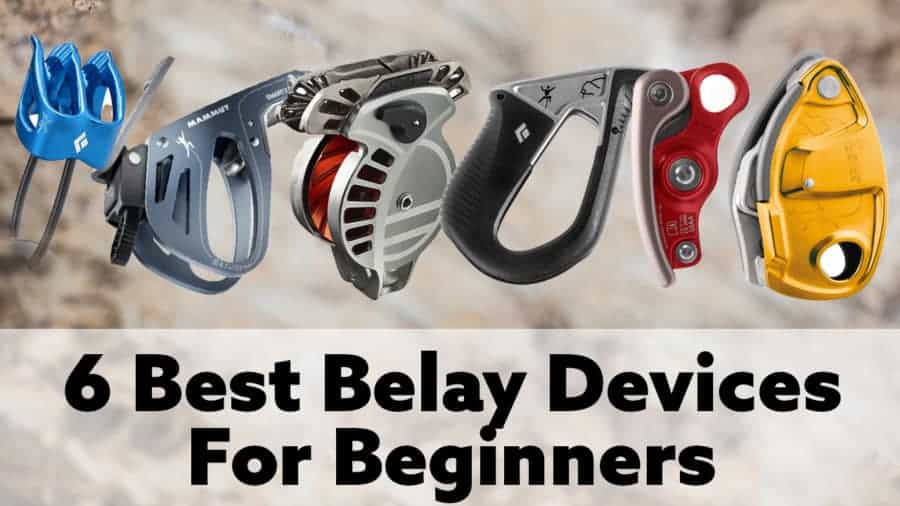I have nine belay devices (tubular, semi-assisted and auto-locking) and I still have a couple on my wish list that I’d like to add to my arsenal so when it comes to climbing gear, you can bet that belay devices are my favorite.
As a beginner climber, I bought the cheapest gear on the market and it worked for me. As long as you are properly belaying, then any brand new belay device should work for you too.
However, if you know how to belay and you are ready to purchase your own device or your second device, you may also be looking for added peace of mind from a device that has extra safety features.
It wasn’t until I made the leap for an auto-locking belay device that I really felt comfortable climbing and belaying. Since then, I only recommend semi-assisted and auto-locking belay devices to my friends and family.
Why Some Climbers Don’t Recommend Assisted Breaking Devices For Beginners
Before we get into the list of recommended belay devices for beginners, this needs to be addressed. There is a difference between first-time belayers and beginners. First-time belayers are people that have never belayed before. In most cases, first-time belayers borrow a belay device or rent one while they are learning to belay. For first time belayers, it may be a good idea to have proper training with an ATC, just in case you need to use one.
Many climbers (usually older climbers) say that you should stick with a tubular ATC for a while before getting an assisted breaking device because it is harder to learn how to properly belay with one.
However, you can learn to “properly” belay on any device. If you only use a Grigri, then why would you need to know the ins and outs of a basic tubular ATC? (Answer: Just in case…)
Though I have recommended one ATC in this article for those that want to spend the least amount of money as possible on a belay device, I recommend that beginner climbers use a device with either semi-assisted and auto-locking features.
By using a assisted locking device, you can climbing wiithout worrying about the belayer dropping you or you dropping them.
Note: As a beginner climber, worrying about whether your belayer is going to catch you will undoubtably prevent you from pushing to your full potential and it will slow progress.
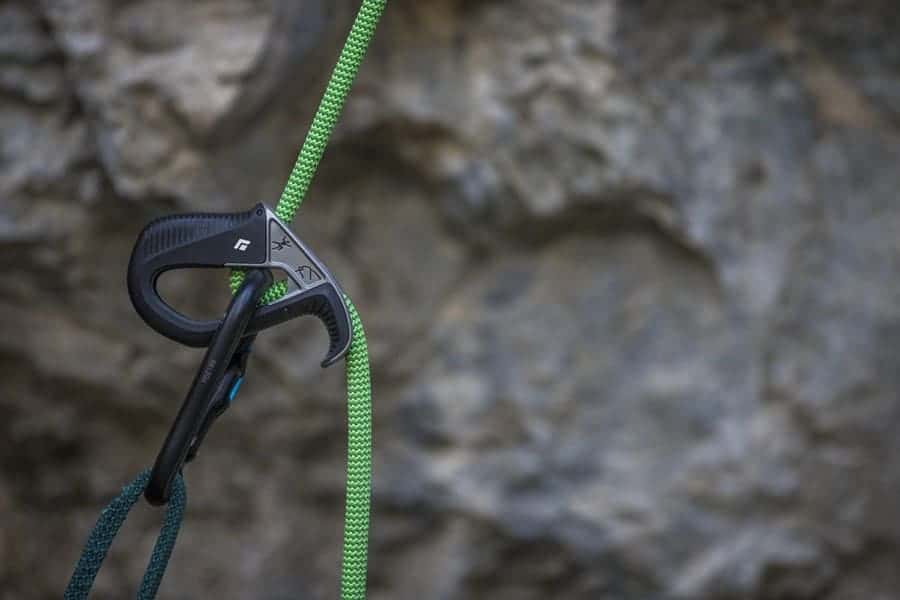
Black Diamond Pilot
- See the price from Backcountry here.
- See the price from Black Diamond here.
- See the price from REI here.
Type: Semi-Assisted Breaking
Overview: This is my newest belay device and I got it specifically because I wanted to try a semi-assisted breaking device to compare it to my auto-locking devices. It functions very simlar to a tubular ATC but it has the added assistance for if a climber falls.
One thing that I really like about this device is how similar it is to feed rope through the device as you would through a basic ATC so there is a minimal learning curve for beginner climbers.
To lower a climber, instead of nervously moving the rope up to the belay device (common for basic ATCs), you move the belay device like you would a lever to control the speed of the rope running through the belay device.
A common thing climbers mention when reviewing this product is that the part that you hold has a plastic coating on it. For some climbers that may seem like a cheap material that should be concerning. However, if I were to climb with a full metal-frame device like this during the summer, it would get too hot and I wouldn’t be able to hold (holding it is necessary for lowering a cimber)
How It Works: The Black Diamond Pilot is made with a tubular form (similar to an ATC) that has a lip where the rope feeds through it. In a nutral position, a position where the the device is facing up, the rope can run through it easily. When the rope tightens between the ATC and the carabiner (what happens when a climber falls), the device turns forward which causes the rope to be pinched between the device and the carabiner preventing it from moving.
To get the rope moving again, the climber has to reposition the belay device by either turning the device up or by using the lip to push the device up.
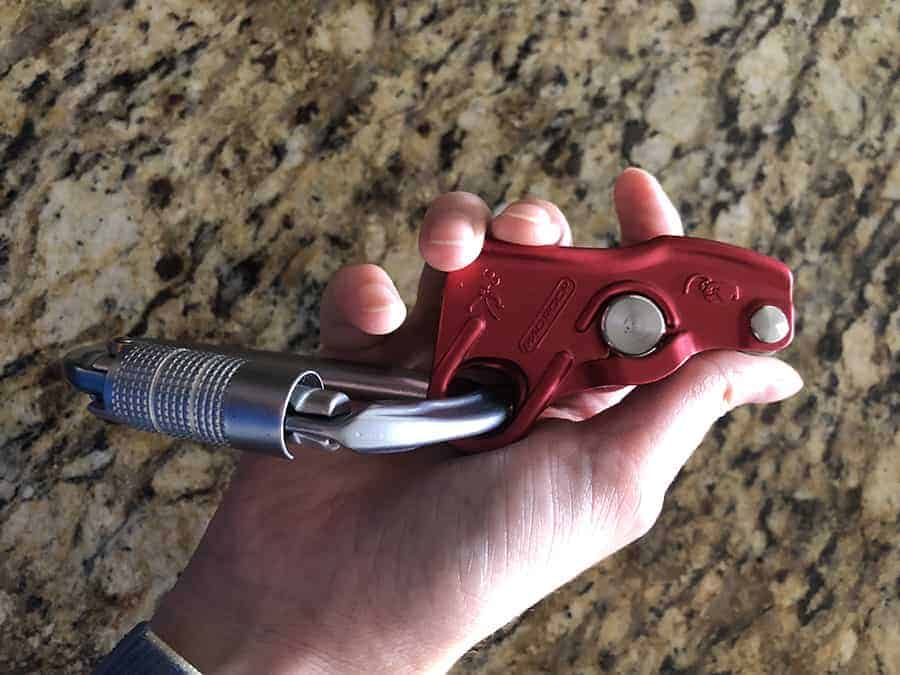
Mad Rock Lifeguard
See the price from Backcountry here.
Type: Auto-Locking
Overview: This and the Black Diamond Pilot (below) are my favorite belaying devices for beginners and advanced climbers. The auto-locking device is similar to the functionality of the Grigri but it takes up less space, it’s lighter and feeding rope/lowering climbers is a little bit easier.
How It Works: The way the Lifeguard works is that it has a cam mechanism inside the device so while you are feeding rope through the device or while you are pulling in slack, the device stays in a nutral position and the rope is able to move through the device.
When a climber falls, the cam pinches the rope and prevents the rope from moving through the device, thus auto-locking the rope and preventing the climber from falling to the ground.
This is great if something happens to the belayer and they are unconsious or if the belayer isn’t paying proper attention to the climber, so you can have the peace of mind that no matter what, you will be caught.
In comparission to the Grigri, there is less friction in the device while it is in nutral position so it is easier to feed rope and take in rope.
For example: I mostly climb with people around my weight, but using the Grigri to lower children on Top-Rope is difficult because you essentially have to feed rope into the device while activating the break release because they are so light. In comparission, the Lifeguard’s smaller profile makes it so there is less friction, and thus you don’t have to feed rope through the device while holding the break release lever so it is easier and it feels safer.
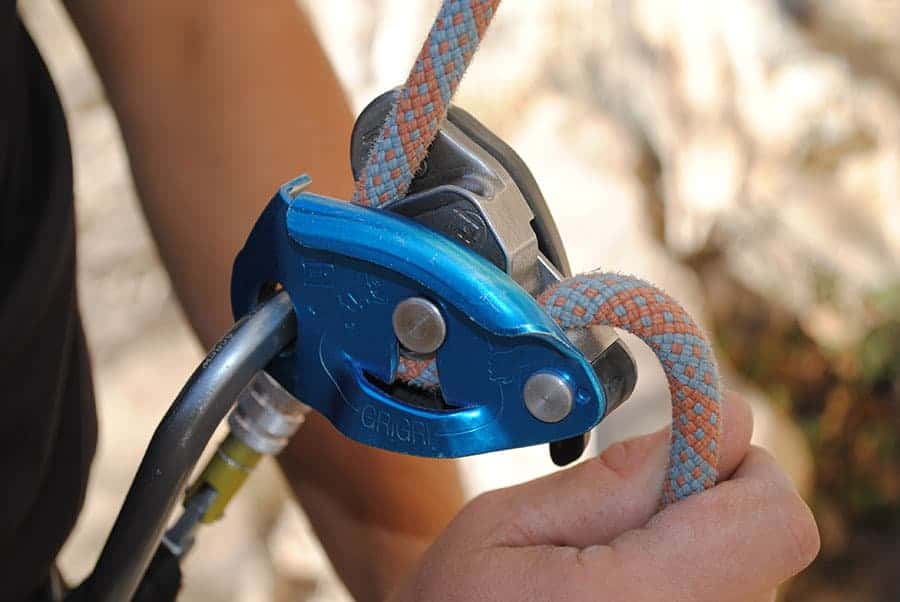
Petzl Grigri+
See the price from REI here.
Type: Auto-Locking
Overview: A few years ago when I asked climbers what they thought about belay devices, the Grigri and Grigri + was what everyone recommended. I realized that I love climbing and wanted to do it more often so I knew that I needed to get one. It was recommended to me to get the Grigri over the Grigri + by a staff member at my local climbing gym and I was told that the Grigri was more simple to use so it would be better for a beginner.
However, now that I am more familiar with Grigri devices, I wish that I had gotten the Grigri+ as a beginner.
The Grigri (Link to product) is a great device but there is an important safety feature in the Grigri+ that solves my biggest concerns with the Grigri. It has a feature that prevents you from holding the break release function when you are paniced. If I had a better understanding of this feature, I would have ignored the recommendation of climbers that probably haven’t used the Grigri+ and would have purchased the Grigri+.
How It Works: The breaking functionality uses a cam just like the lifeguard device does.
When the device is in a nutral position, the way the rope feeds through the device stays open. When the climber falls, the cam pinches the rope and prevents it from running through the device.
In addition, you can switch between top-rope climbing mode and lead climbing mode, which essentially just changes how quickly the device breaks. When you are lead climbing, having a little bit of slack can make your fall safer, however, in top-rope climbing you don’t need extra slack and quicker breaking is essential.
To switch between modes, you turn the knob on the belay device and then press the locking button to ensure that it doesn’t switch modes while you are climbing. It is that easy.
Additional Notes: If you intend on getting the Grigri ($110) instead of the Grigri+ to save money, just get the Mad Rock Lifeguard. It has the same features but it is easier to feed and take in rope, plus it is even cheaper.
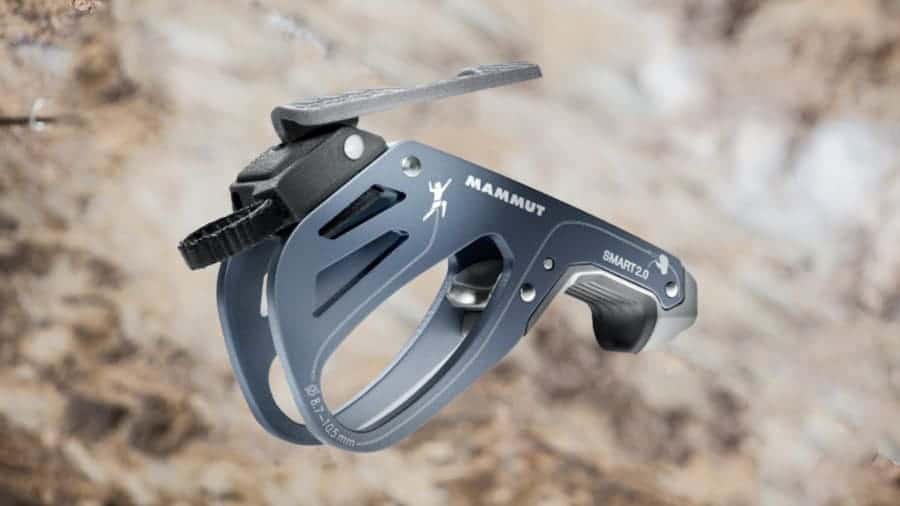
Mammut Smart 2.0 + Smarter Add-On
See the price from REI here.
See the price from Backcountry here.
Type: Semi-Assisted Breaking
Overview: This Mammut Smart 2.0 device is very similar to the Black Diamond Pilot (see above) in functionality but it has a sligthly different design. The add-on called “Smarter”(See the price from Backcountry here) that you can attach to the belay device is why I’ve included it on this list. The Smarter add-on prevents beginner climbers from miss-holding the rope while they are belaying, making it very beginner friendly.
So if you are a climber that is willing to spend an extra $20 for a semi-assisted belay device, this is a great option for you.
How it Works: The smarter 2.0 works almost exactly like the Black Diamond Pilot. When you are feeding rope through the device and there is slack, the belay device stays in a nutral/up-right position.
If the rope tightens, the belay device snaps against the carabiner in a forward position, pinching the rope and preventing it from moving. To get the rope moving again, use your thumb that is holding the safety rope up against the lip of the device to push it into an upright position.
For lowering, you can control the speed that the rope going through the device by pushing up for a faster decent and letting the device naturally go into a sideways/locked position for a slower decent.
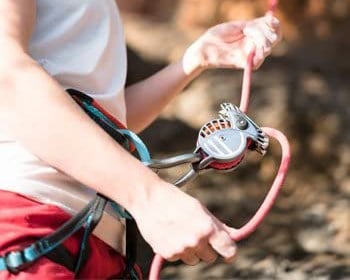
Wild Country Revo
See the price from Backcountry here.
Type: Auto-Locking
Overview: The Revo doesn’t require any deviation from the standard belaying technique, and has the feel of a tube-style belay device, but with the benefit of an emergency locking feature.
I haven’t actually used the Revo yet (It’s at the top of my belay device wish list) but I have watched so many videos that I can’t wait to get my hands on it. Essentially, you feel like you are just moving rope through a pully device and the mechanics inside the device auto-locks when a fall is detected via fast moving rope.
When these devices first came out, I could have sworn they were almost $300 but I must have just been imagining the value because BackCountry has it for $145. This thing is incredible.
You take in slack like every othe belay device, but lowering is more like an ATC than any Auto-Locking devices and thus it is more simple to use.
Most climbers absolutly love the device and feel like its revolutionizing the auto-locking belay device industry.
The biggest concern that some climbers have about this device is that when you are projecting a route and falling a lot, clicking the device out of the locked position takes additional effort compared to just moving your hand like it would be in an ATC.
This isn’t that big of a deal for beginners because it is unlikely that you will be falling on every move for each climb that you do. However, say you do a lot of projecting (which I recommend waiting until you are good at basic climbing technique before you project) then you will see that the additional effort is minimal and the peace of mind is still worth it compared to a basic ATCs.
How It Works: The device uses a spinning cam inside the device and when the cam spins too quickly (a climber falls) then it pinches the rope in place. To minimize accidents that occur from incorrectly loaded belay devices, Wild Country designed the Revo to be bi-directional, meaning the device works in both directions. This also makes it simple for someone who is left-handed to use the device without having to adapt their belaying technique. Additionally, the emergency locking function is panic-proof, and can’t be overridden by incorrect handling.
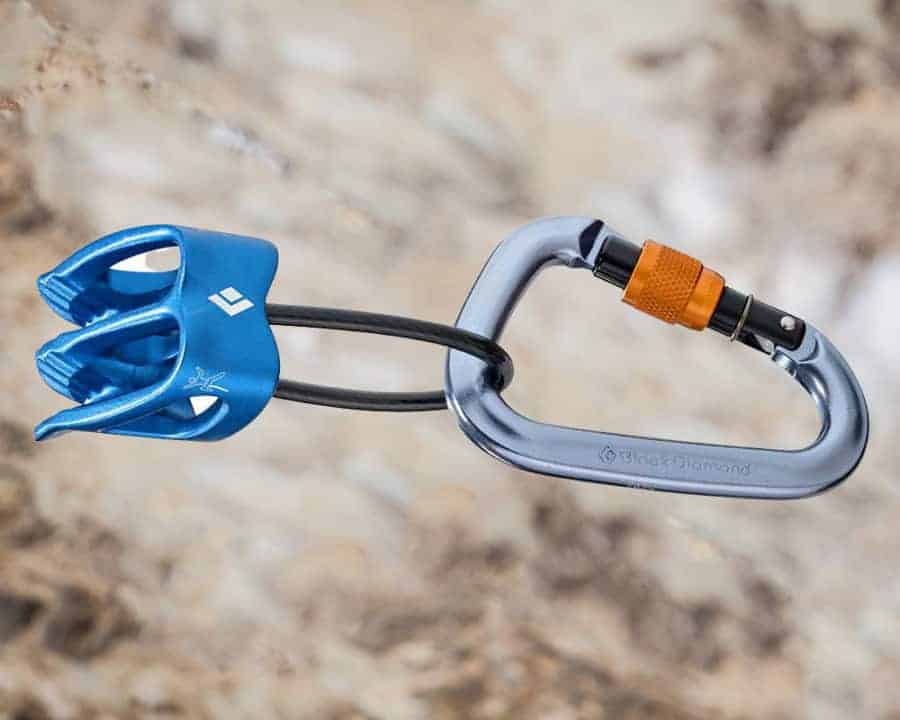
Black Diamond ATC-XP Belay Device
- See the pricing from Black Diamond here.
- See the price from REI here.
- See the price from Backcountry here.
Type: Tubular ATC
Overview: I recognize that for some beginner climbers, they may not want to invest very much into their climbing gear. If that is the case, then consider spending an extra $15-$20 on a semi-assisted breaking device like the Black Diamond Pilot (see above).
If you aren’t willing to spend any more than what is socially acceptable than this is a great ATC device to use.
It has teeth for added grip when you are breaking and it is made with windows on the side so it doesn’t weigh as much as a solid ATC (though weight is less important for beginner climbers).
It is the top rated belay device on Back Country and has been reviewed by many as being perfect for any climber.
Many climbers that have used this device say that it is very durable and can handle any situation, including rappelling. It can switch from stop to go very quickly and with easy control.
One nice thing with how cheap this ATC is is that when the teeth wear down after a lot of use, you can easily replace.
Additional Notes: I no longer climb with basic ATCs unless I’m with a group of people and we don’t have enough auto and semi-assisted breaking devices in the group. Some older climbers think it is very important to learn how to belay on a tubular device before getting an assisted breaking device so that the risk inovlved with the climber will force you to belay properly, however, for most climbers it is only necessary if you intend on using an ATC.
More Buyer’s Guides:
- The Top 5 Crash Pads For Bouldering: How To Decide Which Is Best
- Diy Hangboard With Jugs And Edges For Less Than $15
- 6 Of The Best Belay Devices For Beginner Climbers
- The Best 11 Climbing Shoes Under $100
- Climbing Chalk: Chunky Vs. Fine
- The Best Chalk For Climbing And Bouldering
- Rock Climbing Starter Kits For Beginners Compared
- Liquid Chalk Vs. Dry Chalk For Bouldering (Hint: Dry Chalk Is Better)
- Top 5 Gear You Need In Your Climbing Pack For The Best Experience
- What To Wear While Bouldering
- Should You Upgrade To An Assisted-Braking Belay Device?
- Everything You Need To Know About Climbing Chalk
- 37 Things Serious Climbers Bring With Them To The Mountains
- Clothing For Climbing In The Gym – What Should You Wear?
- Can You Climb Without Chalk?
- How Tight Climbing Shoes Should Fit For The Best Performance
- Harnesses For Rappeling
- My Favorite Harness For Climbing
- What You Should Wear While Climbing
- What Affects How Climbing Shoes Fit?
- How To Clean Your Grigri
- How To Care For Your Climbing Rope

